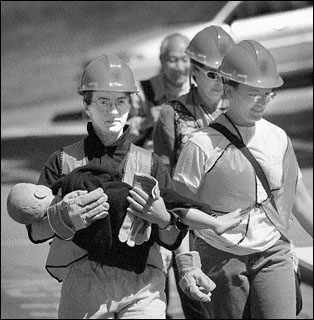![]()
Stories
for June 7, 2000
![]()
![]()
![]()
|
|
||||
|
|
|
|
|
|
|
|
||||
Transportation researcher Benedicte Bougler carried a child mannequin, wrapped in a blue fleece jacket, to a medical triage station outside Valley Life Sciences. It was 10:30 a.m. the morning of Berkeley's Quake 2000 disaster exercise, and her team had just rescued the "victim" and three others from Mulford Hall.
"So what's happening with the baby?" inquired a triage worker.
"It's in shock."
"'If the face is red, raise the head; if the face is pale, raise the tail,'" the volunteer recited, recalling her first aid training with the campus's HOME Team disaster response program.
Carefully, Berkeley staffers lowered the inflatable child into shock position on a bright patch on the lawn -- and then went the extra mile, assigning someone to shade the baby from the sun.
Such quick thinking, teamwork and simulated heroism, along with a sense of humor, was replicated throughout the morning of May 25, as 400 campus staff and students took part in the largest disaster field training ever conducted by a California university. (continues)
![]()
![]()
![]()
[HOME] [SEARCH] [ARCHIVE] [ABOUT] [CONTACT] [MORE
NEWS]
![]()
June 7 - July 11,
2000 (Volume 28, Number 34)
Copyright 2000, The Regents of the University of
California.
Produced and maintained by the Office
of Public Affairs
at UC
Berkeley.
Comments? E-mail berkeleyan@pa.urel.berkeley.edu.


